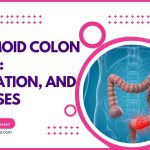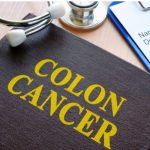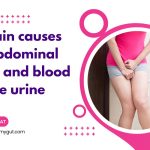Yellow Stool & Abdominal Pain: 11 Causes Explained In-depth
Your stool acquires its normal brown color via the breakdown of bilirubin inside your intestine. Yellow stools can occur by a variety of mechanisms.
- Diarrhea: Not enough time to process your stool to its normal brown color (speeding up of stool passage through the colon)
- Less bilirubin reaching your intestine: as with bile duct obstruction, bilirubin is the source of the brown color of stool.
- Excess bilirubin reaching your intestines exceeds your intestine’s capacity to break it down. (as with inflammation of the liver, “hepatitis”).
- More fat in your stool as with eating large fatty meals or conditions leading to fat malabsorption.
- Eating too many yellow-colored foods.
Here, We will discuss the COMMON causes of yellow stools and abdominal pain simultaneously.
1- Stomach flu (viral gastroenteritis).
Infection of your intestine by viruses is common; it causes severe diarrhea and colics.
If your stool is just yellow without diarrhea, stomach flu is unlikely.
Viral Gastroenteritis is the most common cause of infectious diarrhea (58.7% of infectious diarrhea are caused by viruses, commonly:
- Norovirus.
- Rotavirus.
- Astrovirus.
Norovirus became the most common cause of viral gastroenteritis after the invention and the widespread use of the Rotavirus vaccine.
Gut viruses cause both abdominal pain and yellow diarrhea are caused by speeding up of your gastric contents and impairment of fat absorption.
How to suspect stomach flu (symptoms):
- Severe abdominal cramps (mainly lower abdomen.
- Diarrhea and yellow loose stool.
- Upper abdominal pain (stomach pain).
- Nausea and vomiting can occur.
- Low-grade fever.
- Body aches, headache.
How to deal?
- The condition is usually self-limiting within a few days.
- Eat easily digestible foods such as BRAT (Bananas, Rice, Applesauce, Toast).
- Avoid high-fat foods, caffeine, and sugary foods.
- Call your doctor if you suspect covid-19, have a high-grade fever, bloody diarrhea, or sharp intolerable pain that is not going away.
CAUTION!
Fever, Diarrhea, Yellow stool, and abdominal pain can result from COVID-19 infection. Immediately consult your health care provider if you encounter fever or any suspicious symptoms of COVID-19, such as:
- Lack of taste or smell.
- Severe bony aches and malaise.
- Shortness of breath.
- Cough, sputum.
- Severe headache.
- Rapid breathing or rapid heartbeats.
– Indigestion of a large fatty meal
2- Giardiasis & other infections.
Apart from viral gastroenteritis, other gut bugs can cause infection to your gut, commonly bacterial infections, protozoa, and parasites.
They cause yellow stool by speeding up the stool passage (diarrhea), abdominal pain, and colics.
Giardiasis is a protozoan that is famous for causing severe yellow diarrhea. It specifically causes “yellow stools” by decreasing fat absorption.
Viral gastroenteritis primarily affects your small intestine, while bacteria and protozoa mainly affect the colon.
The symptoms of bacterial gastroenteritis are generally more severe than viral gastroenteritis, with more fever, colics, blood, or mucus in stool.
Symptoms:
- Abdominal pain is more severe than stomach flu, with attacks of intense abdominal cramps.
- Diarrhea can be yellow with mucus or blood.
- Fever is usually high-grade, especially with bacterial gastroenteritis.
- Vomiting and nausea are present but generally less than viral gastroenteritis.
- Tenesmus and dysentery are common, especially with amoebic and shigella infections.
These infections can be acquired by contaminated hands or food. Acquiring the infection by eating contaminated food or drinks is called “foodborne illness” or “Food Poisoning.”
How to deal?
- The same as viral gastroenteritis. It is important to keep yourself hydrated, as diarrhea can be severe.
- Eat soft, easy-to-digest foods and avoid high-fat and fried foods.
- Consult your doctor if the fever is a high grade, severe bloody diarrhea, or signs of dehydration.
MORE: Causes of Severe Stomach Pain & Diarrhea in The Middle of the Night.
3- Food: intolerance, allergy, and yellow foods.
Food intolerance
Sporadic attacks of abdominal pain and yellow stool can be due to gut intolerance to certain foods.
It is usually caused by the inability of your intestine to digest and absorb certain types of food fibers or sugars.
Food intolerance is common. It is estimated that 15-20% of people have a food intolerance (ref).
According to the severity of intolerance and how often you eat the offending food, symptoms may vary from:
- Occasional abdominal pain, gases, and stool changes.
- Persistent chronic diarrhea, yellow stools, abdominal pain, and bloating.
Common foods causing intolerance:
- Lactose intolerance: lactose is a sugar in milk and dairy products, a common form of food intolerance.
Severe forms are usually present in early childhood with severe diarrhea, distention, and abdominal pain. But it can also present with mild symptoms in adults after ingesting too much lactose, such as abdominal pain, yellow stools, and maybe diarrhea.
This article explains how you can become lactose intolerant later in life. - Fructose Malabsorption (intolerance): Fructose is a simple sugar. It comes mostly from fruit, honey, and some vegetables.
Overconsumption of fructose is common due to the high intake of refined foods nowadays.
Symptoms are similar to lactose intolerance with bloating, abdominal pain, diarrhea, or yellow stools. LEARN MORE - Intolerance of certain types of alcohol.
- Gluten is a common type of food intolerance. It causes severe diarrhea, anemia, bloating, yellow stool, and abdominal pain.
The severe form is called celiac disease. Milder forms of gluten sensitivity are present (Non-celiac gluten sensitivity.
Learn more about Celiac disease HERE.
Learn more about Non-celiac Gluten sensitivity HERE. - Caffeine intolerance.
- Amines intolerance.
- FODMAP intolerance in patients with IBS. Learn more.
Food Allergy.
Food allergy is different from food intolerance. While food intolerance is just “difficulty digesting and absorbing certain foods, Food allergy is an immune-mediated creation of certain foods you eat.
It is less common than a food allergy, affecting only 2-5% of people (ref).
Not only food allergy produces Gut symptoms similar to food intolerance, but also it can produce severe allergic reactions, such as
- Swollen lips or face.
- Skin allergy as redness, swelling, and itching.
- Difficulty swallowing.
- It may cause life-threatening laryngeal edema with difficulty breathing.
Common foods causing food allergies:
- Nuts, peanut.
- Raw meat, seafood.
- Mustard
- Rice!
- Some vegetables and fruits.
Some yellow foods:
Some yellow foods can cause your stool to become yellow. These foods usually don’t trigger abdominal pain, but you should consider them whenever you experience yellow stool.
Review what you ate before the appearance of the yellow stool. You may find some of the below foods that cause yellow stools:
- Sweet potatoes.
- Carrots.
- Tumeric.
- Yellow pigment-containing foods.
4- Stress.
Stress, anxiety, and other psychological stressors occur almost to everyone.
Your gut is the first and most affected organ by your brain and psychological status. The mind-gut connection is one of the most common causes of unexplained gut symptoms.
Stress and anxiety are major contributors to the development of Functional GI diseases, especially Irritable bowel syndrome.
You don’t have to be diagnosed with irritable bowel syndrome to experience stress-related gut symptoms.
Daily stress or anxiety can trigger abdominal pain, loose yellow stools, or diarrhea.
Here are some interesting facts about stress, anxiety, and your gut:
- Your gut has an entire nervous system in the form of nerve cell plexuses around the intestine.
- These nerve cells residing in the gut are more than the entire spinal cord neurons (ref).
- Stress can induce nausea, abdominal pain, loose stools, or diarrhea.
- IBS, Peptic ulcers, GERD, and Inflammatory bowel disorders are all related to stress.
- Microbiomes (the beneficial micro-organisms inside your intestines) are connected to your brain; they can affect each other.
If you encounter abdominal pain, yellow stools, or diarrhea whenever you feel stressed, consider this the primary cause.
If you suspect irritable bowel syndrome, learn how IBS is diagnosed here.
5- Alcohol and Caffeine.
Although we mentioned alcohol and caffeine under food intolerance causes, we must give them special attention due to their wide use.
Instead of thinking of the serious causes of yellow stool and abdominal pain, thinking of bad drinking habits is better.
Excess alcohol or caffeine can irritate your gut, causing cramps, loose yellow stool, or even diarrhea.
Review the list of what you drink before the onset of yellow stool and abdominal pain.
Alcohol can cause harm to your gut in the form of:
- Large amounts of alcohol can trigger gut inflammation and abdominal pain.
- Alcohol can disturb the ecosystem of beneficial micro-organisms inside your colon.
- Vitamin malabsorption and vitamin deficiency.
- Pancreatic and liver inflammation and damage (which can also be a cause of yellow stool).
- It can trigger other symptoms, such as diarrhea, gas, and bloating.
- Some alcohols contain fructose, artificial sweeteners. These constituents can trigger abdominal pain and loose yellow stools.
Learn more about alcohol, your gut, and IBS here.
Caffeine is a beneficial drink with powerful anti-oxidant effects. However, caffeine abuse in large amounts or sensitivity can lead to abdominal pain and yellow stool every time you drink it.
If the pain and stool changes are triggered every time you drink coffee or other caffeinated drinks, consider cutting it off and watch if symptoms disappear.
6- Medications.
Another thing to consider as a common (& overlooked) cause of abdominal pain, yellow stools, or diarrhea is MEDICATIONS.
New or chronic medications can affect your gut and cause side effects, including pain and stool changes.
Review any recent medications and the list of your chronic medication for any offending drug that can cause abdominal pain and yellow stools:
- Laxatives: large doses of laxatives can cause abdominal bloating, pain and may induce loose yellow stools.
Commonly: Lactulose, Docusate sodium, and Magnesium oral solutions and laxatives. - Some antibiotics can harm your gut health by killing the beneficial bacteria or inducing inflammation.
The common antibiotic that can cause abdominal pain and yellow stools are clindamycin, Penicillins, and cephalosporins.
Learn more about the harmful effects of antibiotics on your gut health and how to restore your gut health after antibiotic use HERE. - Some Diabetes Mellitus medications, such as metformin.
- GERD, gastritis, and peptic ulcer medications (Proton Pump inhibitors, H2 blockers) may cause an overgrowth of harmful gut microbes and cause symptoms such as abdominal pain, bloating yellow loose stool.
- Chemotherapy (anticancer medications).
- Immunosuppressive medications are used in autoimmune diseases like Rheumatoid arthritis, Systemic lupus Erythromatosis, and Idiopathic thrombocytopenic purpura.
The medications that can cause diarrhea and yellow stools are discussed here.
Please consult your doctor about any meditation you use and its relation to abdominal pain and stool color changes.
7- Irritable bowel syndrome (especially with diarrhea).
Another common cause of abdominal pain and loose yellow stool is Irritable bowel syndrome.
IBS affects around 11 to 15% of the population (ref). There is no reliable test to diagnose IBS; IBS is diagnosed according to some clinical criteria.
The fundamental symptom of IBS is abdominal pain that occurs at least once per week. The onset of abdominal pain is associated with at least 2 of the following:
- Defecation: abdominal pain is relieved (or worsened) during or after defecation.
- Change in stool form: stool becomes more hard or loose (and yellow).
- Change in stool frequency: more frequent or less frequent bowel movements (constipation or diarrhea)
A surprising fact about IBS:
Only 30% of people matching the criteria of IBS will consult their doctors about IBS symptoms (ref).
This leaves 70% of people matching the diagnostic criteria of IBS without even knowing they’ve IBS!
If you have recurrent abdominal pain and yellow stool, Read this in-depth guide to determine if you have IBS.
8- Acute Hepatitis (& other liver diseases).
Acute liver inflammation (commonly due to the hepatitis A virus) can cause abdominal pain and yellow stool (ref).
Overproduction of bilirubin by the inflamed liver can lead to yellow stool.
Symptoms of acute hepatitis:
- Usually starts with nausea, abdominal pain (mainly in the upper right abdomen)
- Yellowish discoloration of the skin, sclera (eye whites),
- Dark urine, pale yellow stools.
- Vomiting may occur.
- Fatigue and loss of appetite.
- Fever can also occur.
Learn more about hepatitis A infection here.
Other liver conditions that can cause yellow stool and abdominal pain:
- Acute hepatitis is due to causes other than hepatitis, such as acute hepatitis B and autoimmune hepatitis.
- Acute fulminant liver failure.
- Chronic hepatitis, such as chronic hepatitis c.
- other rare liver diseases include PBC (Primary Biliary Cholangitis), Wilson’s disease, and hemochromatosis.
9- Gall bladder issues.
The gallbladder can contribute to abdominal pain and yellow, pale stools; many gallbladder conditions can cause such conditions as:
- Acute inflammation (cholecystitis).
- Gallstones (cholelithiasis).
- Bile duct obstrcution.
- Bile acid Malabsorption
Can the removal of your gallbladder cause persistent abdominal pain and yellow diarrhea?
According to Dr. Michel from Mayoclinic, about 20% of people undergoing gallbladder surgery may develop diarrhea (ref). Also, symptoms of gallbladder inflammation may persist after surgery. This condition is called “Post-cholecystectomy syndrome” (ref).
10- Celiac disease.
Celiac disease is a form of food intolerance (to wheat and barley). In its severe form, celiac disease leads to persistent yellow diarrhea, abdominal pain, anemia, and fatigue.
The classical disease is very severe; its age of presentation is usually between 20-30 years of age.
Don’t consider celiac disease if you don’t have chronic yellow diarrhea.
11- Pancreatic Diseases.
Acute inflammation of the pancreas leads to severe abdominal pain and loose yellow stools; the condition is usually severe, with sharp stopping pain in the upper part of your abdomen.
In some cases, the inflammation may become chronic and lead to a deficiency of the digestive enzymes (pancreatic Exocrine deficiency). This condition leads to chronic yellow diarrhea, especially after eating fatty foods.
Fast facts about EPI (Exocrine Pancreatic Insufficiency):
- Common in alcoholics and people with chronic pancreatitis.
- The condition may be mild, and diarrhea occurs only after you eat fatty foods.
- More severe disease can present with severe greasy diarrhea, abdominal pain, bloating, weight loss, and vitamin deficiency.
- Suspect if you have a history of pancreatitis.
- Treatment is usually by the replacement of deficient pancreatic enzymes.
Related Posts:
- 5 Causes of Lower Abdominal Pain When Coughing &…
- 5 Main causes of abdominal pain and blood in the urine
- How Long Do Hiccups Last? 7 Scenarios Explained.
- Liver Pain in Females: Location, Causes, Pregnancy, & More.
- Stomach Pain after Emptying the Bladder: Causes…
- Can Gallbladder Pain Affect your Back Only?…






